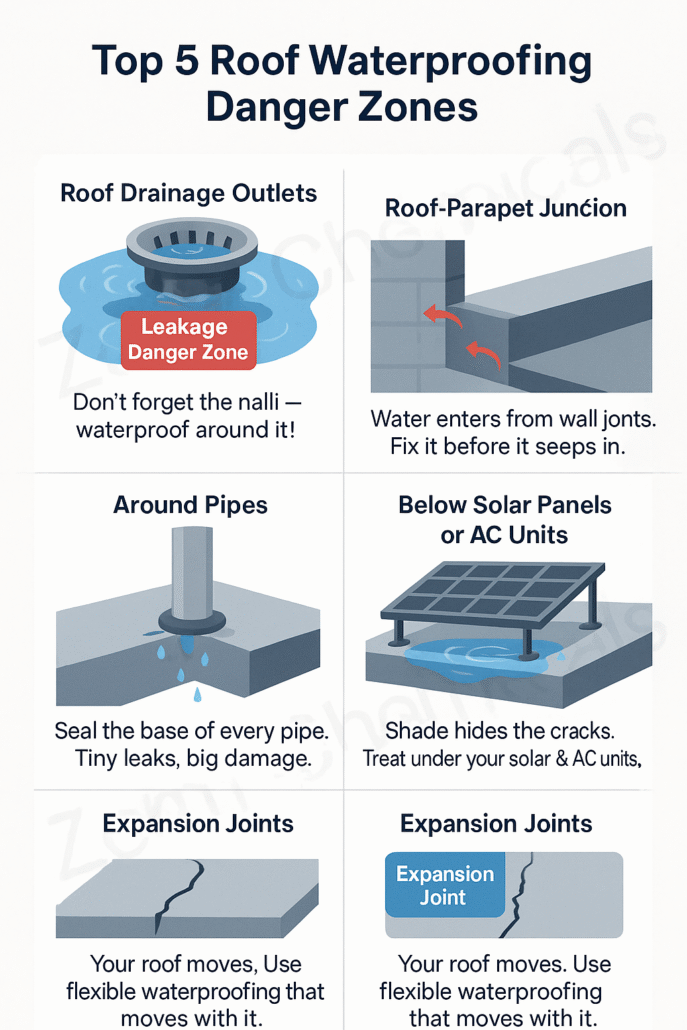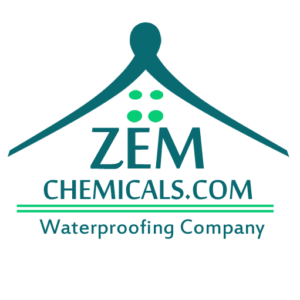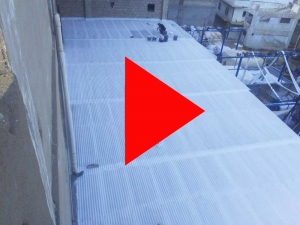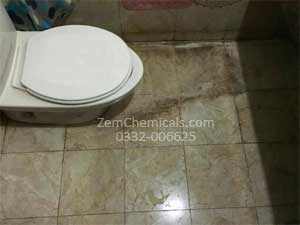5 Most Overlooked Roof Areas That Cause Waterproofing Failure and How to Treat Them
When it comes to roof waterproofing, most homeowners and even contractors focus on applying a waterproof layer to the visible flat surface of the roof. But what if we told you that some of the most common sources of leakage are areas people tend to ignore?
A roof is not just a flat slab—it’s a structure made of multiple elements working together. Overlooking even one critical spot can lead to water seepage, mold growth, and expensive structural damage. In this article, we’ll highlight five often-ignored areas of the roof that are responsible for most waterproofing failures—and how to treat them effectively using water-based solutions.

1. Roof Drainage Outlets (Nallis)
🔍 Why It’s Overlooked:
Drainage outlets, or nallis, are designed to let water flow off the roof. But these areas constantly stay wet, and if not sealed properly, water can seep through the concrete or around the pipe edges.
💧 Water-Based Solution:
Apply a flexible acrylic waterproofing coating with a brush directly into and around the outlet. Reinforce with a fiber mesh to strengthen the area and prevent cracks. Make sure there’s a smooth slope guiding water toward the outlet to avoid pooling.
✅ Pro Tip:
Use a three-coat water-based acrylic system around all nallis—especially if your roof holds water after rain.
2. Parapet Wall and Roof Junction
🔍 Why It’s Overlooked:
This is where the vertical parapet wall meets the horizontal roof slab. Tiny gaps and hairline cracks often appear here due to thermal expansion, allowing water to penetrate and seep downward.
💧 Water-Based Solution:
Use a polymer-modified water-based coating with high flexibility. Apply a 4 to 6-inch band across the junction with a non-woven fabric mesh embedded for reinforcement.
✅ Pro Tip:
Always check the full length of all corners, not just visible spots. Parapet junctions are the #1 hidden leakage source in many Karachi and Lahore homes.
3. Around Pipes, Conduits, and Base of Antennas
🔍 Why It’s Overlooked:
Pipes entering or exiting the roof—like plumbing vents or electrical conduits—are usually surrounded by small gaps. These are entry points for moisture if left untreated.
💧 Water-Based Solution:
Clean the area and seal any gaps with a water-based elastomeric sealant. After drying, apply a brush-on liquid acrylic waterproofing membrane around the base of the pipe extending a few inches onto the roof.
✅ Pro Tip:
Avoid using cement to patch pipe bases—it cracks over time. Instead, always use flexible, breathable water-based systems.
4. Under Solar Panels, Water Tanks, or AC Units
🔍 Why It’s Overlooked:
When heavy equipment like solar panels, water tanks, or outdoor AC units are placed on the roof, the surface beneath is rarely waterproofed first. These areas stay shaded and humid—ideal for hidden cracks and slow seepage.
💧 Water-Based Solution:
Before installation, apply a fiber-reinforced water-based coating under and around the placement area. If the equipment is already installed, waterproof around the edges using a roller-applied elastomeric coating with added anti-microbial agents.
✅ Pro Tip:
Lift the equipment slightly (if possible) for better access. Even partial coating around the base can make a big difference in protection.
5. Expansion Joints or Structural Cracks
🔍 Why It’s Overlooked:
Some buildings have built-in expansion joints or develop natural cracks over time due to building movement. These joints are flexible and prone to repeated cracking, which breaks the waterproof layer.
💧 Water-Based Solution:
Use a high-elasticity water-based membrane specifically designed for moving joints. Apply in multiple coats with a joint tape embedded for added strength. Ensure the product offers UV resistance if the joint is exposed to direct sunlight.
✅ Pro Tip:
Inspect joints annually—especially in older buildings or multi-story homes. Expansion joint failure is gradual but highly damaging.
Why Water-Based Roof Waterproofing Is the Best Choice
Water-based solutions have improved dramatically over the last few years. Today’s high-performance roof waterproofing products offer:
-
Low VOCs (eco-friendly)
-
Easy application by brush or roller
-
Excellent adhesion on concrete surfaces
-
Flexibility to withstand temperature changes
-
UV resistance for long-term durability
Most importantly, water-based systems are safer and faster to install, making them ideal for residential roofs in urban environments like Karachi, Lahore, and Islamabad.
Roof waterproofing isn’t just about coating the surface—it’s about understanding your roof’s weak points and treating them proactively. By paying attention to these five often-overlooked areas and using high-quality water-based solutions, you can ensure a leak-free roof that lasts for years.
If you’re noticing damp spots, seepage, or signs of leakage, don’t wait for the next rainfall to test your luck.
📞 Call Zem Chemicals today at 0332-0066625 for a professional inspection and affordable, long-lasting waterproofing services in Karachi.











